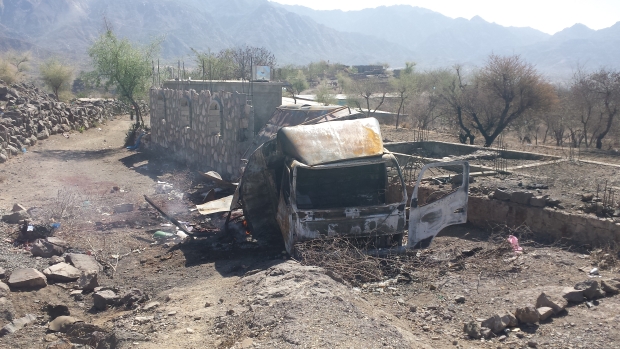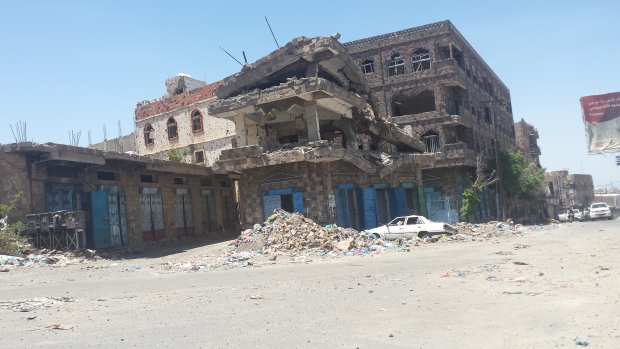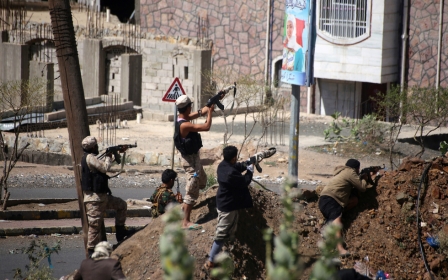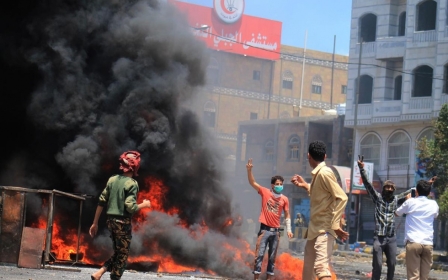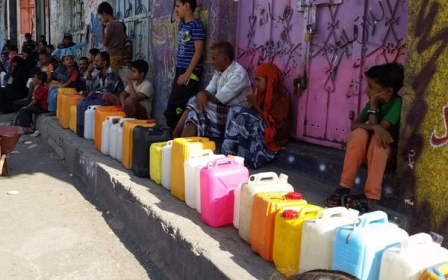Siege of Taiz broken but residents face new dangers under resistance rule

TAIZ, Yemen - When Jameel al-Habashi, a trader in the al-Nashama area about 20km from Taiz city, heard that the resistance had broken the siege there earlier this month, he loaded his van with biscuits and chocolates to sell there.
Driving through the al-Dhabab area at the southwestern entrance to Taiz, Yemen’s third-largest city, Habashi’s van hit a mine that killed both him and his friend Saleem.
Houthi rebels who had previously occupied the centre of the city had planted hundreds of landmines as they fled, and the Popular Resistance, which is loyal to Yemeni President Abd Rabbuh Mansour Hadi, allowed people to drive through the area rather than waiting for minesweeping equipment to arrive from the government-controlled southern port of Aden.
The Saudi-led coalition helped pro-government forces to recapture Aden last summer and has carried out a year-long air campaign to stop the Houthis, who support Yemen's ex-president Ali Abdullah Saleh, from taking over the country, although they remain in control of Sanaa, the capital.
Jamal al-Habashi, Jameel's brother, told Middle East Eye that he held both the Houthis and the resistance responsible for his brother's death.
"The resistance broke the siege on 11 March. My brother loaded the van on 12 March and headed for Taiz. His luck was bad and he hit a mine that killed him and his friend, and his goods and van were burnt completely," he said.
"When I told fighters of the resistance in al-Dhabab that they had participated in killing my brother, they told me that my brother was a 'martyr,' and they said they didn’t have a minesweeper, so they just let cars pass through," he said.
Jamal said he was sad not only about his brother but for all those who had been killed by mines in al-Dhabab.
"On the second day after breaking the siege, about five cars hit mines that killed more than 10 people, including two children in al-Dhabab," he said.
The Houthis planted mines in several areas of Taiz, but they mined the al-Dhabab road heavily because it is an important entrance to the city.
Hamza al-Raseni, the commander of the al-Dhabab checkpoint, told MEE that the resistance had been fighting for months to break the siege and could not wait for minesweepers to arrive to clear the road.
"There were hundreds of casualties inside the city because of the siege, so we allowed cars to move in and break the siege quickly. Casualties from the mines in al-Dhabab have been less than 15, and they’re all martyrs, so this isn’t a high price to break the siege," he said.
Raseni said that the resistance still did not have minesweeping equipment and was searching for mines manually.
Spread of weapons
With the siege broken, both humanitarian supplies and military reinforcements have arrived in the city, prompting resistance fighters to provide Kalashnikovs and other weapons to youths to protect their neighbourhoods from the Houthis, who still occupy a few areas and are capable of mounting attacks elsewhere.
Safwan al-Sayed, a teacher in the al-Tahreer al-Asfal neighbourhood, said armed youths and children spread through the area after getting weapons from the resistance.
"I used to see the kids of our neighbourhood with their books and pens … and nowadays they've become armed men," Sayed told MEE.
Since the area had come under control of the resistance, he said there had been random shooting every night, and he feared that more than actual gunfights.
"These kids don’t know that weapons should be used only in battles. Every night they shoot in the air, and when we ask the reason, they say they want to tell the Houthis they’re here to protect the city," Sayed said.
The Popular Resistance has provided weapons across all the liberated areas of Taiz.
A youth in al-Moroor, Mulaham al-Muhya, said the resistance had given him a Kalashnikov early last week to protect against the Houthis attempting to recapture the neighbourhood.
Al-Muhaya declined to give his age or talk about his experience in using the rifle. He called for his supervisor, who declined to give any details and accused MEE's journalist of being a Houthi supporter.
The fighters usually decline to speak, but it is clear that they have spread to many neighbourhoods, possibly offering them protection from the Houthis but certainly also instilling fear among civilians.
Escalation of fighting
When the Houthis were driven from the southwestern areas of Taiz, they escalated fighting in the eastern and northern areas, causing a blockage of connecting roads.
Bus driver Solaiman al-Qadasi, 29, told MEE: "When Taiz was under siege, we were able to move between different areas, but now we can’t go to areas under the control of the Houthis."
During the siege, clashes took place mostly at the entrances to the city, but now they have moved inside, creating fear among residents as they listen to the battles and wait for rockets to target them, Qadasi said.
"We don’t care who takes over the city, we want to live peacefully, but conditions are worsening daily, even since the siege was broken," Qadasi said.
Some displaced people who fled Taiz about a year ago have returned and expressed shock to see militant fighters patrolling areas under the control of the Popular Resistance.
"Taiz is the cultural capital of Yemen. We aren’t used to seeing fighters moving around, so I was shocked to see so-called Islam Guards fighters moving through our neighbourhood in the Bab Mosa area," Mohammed al-Asal, a displaced man who returned to his house early last week, told MEE.
The Islam Guards are a Sunni militant group that appeared in Taiz last year, fighting the Houthis for sectarian reasons. Some people in Taiz accuse them of being affiliated with al-Qaeda.
Asal said he would return to his village in al-Maafer district, 30km from Taiz, because he does not feel safe living in a city with militants.
Asal said: "Displaced people shouldn’t return to their houses. Many problems still face them in Taiz, including fear of the Islam Guards.”
Middle East Eye propose une couverture et une analyse indépendantes et incomparables du Moyen-Orient, de l’Afrique du Nord et d’autres régions du monde. Pour en savoir plus sur la reprise de ce contenu et les frais qui s’appliquent, veuillez remplir ce formulaire [en anglais]. Pour en savoir plus sur MEE, cliquez ici [en anglais].


